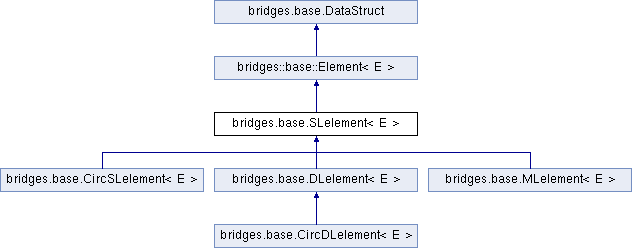|
Bridges-Java-2.3.3
2.3.3
Bridges(JavaAPI)
|
|
Bridges-Java-2.3.3
2.3.3
Bridges(JavaAPI)
|
This class can be used to instantiate Singly Linked Elements. More...

Public Member Functions | |
| SLelement () | |
| SLelement (String label, E e) | |
| SLelement (E e, SLelement< E > next) | |
| SLelement (E e) | |
| SLelement (SLelement< E > next) | |
| String | getDataStructType () |
| SLelement< E > | getNext () |
| void | setNext (SLelement< E > next) |
| String | toString () |
| String | getDataStructureRepresentation () |
 Public Member Functions inherited from bridges.base.Element< E > Public Member Functions inherited from bridges.base.Element< E > | |
| String | getDataStructType () |
| Element () | |
| Element (E val) | |
| Element (String label, E val) | |
| Element (Element< E > original) | |
| String | getIdentifier () |
| ElementVisualizer | getVisualizer () |
| void | setVisualizer (ElementVisualizer visualizer) |
| LinkVisualizer | getLinkVisualizer (Element< E > el) |
| String | getClassName () |
| int | compareTo (Element< E > e1) |
| boolean | equals (Element< E > e1) |
| String | getElementRepresentation () |
| String | getLinkRepresentation (LinkVisualizer lv, String src, String dest) |
| String | getLabel () |
| void | setLabel (String label) |
| String | arrangeLabel (String label, int wordNumber) |
| E | getValue () |
| void | setValue (E value) |
| String | toString () |
 Public Member Functions inherited from bridges.base.DataStruct Public Member Functions inherited from bridges.base.DataStruct | |
| abstract String | getDataStructType () |
Protected Member Functions | |
| void | getListElements (Vector< Element< E >> nodes) |
 Protected Member Functions inherited from bridges.base.Element< E > Protected Member Functions inherited from bridges.base.Element< E > | |
| void | setLinkVisualizer (Element< E > el) |
| void | removeLinkVisualizer (Element< E > el) |
| void | validateVal (E value) |
Protected Attributes | |
| SLelement< E > | next = null |
 Protected Attributes inherited from bridges.base.DataStruct Protected Attributes inherited from bridges.base.DataStruct | |
| String | QUOTE = "\"" |
This class can be used to instantiate Singly Linked Elements.
This class extends Element and takes a generic parameter <E> representing application specific data. This element forms the basic building block for singly linked lists. Singly linked elements have a field pointing to the next element along the list.
Elements contain a visualizer (ElementVisualizer) object for setting visual
attributes (color, shape, opacity, size), necessary for displaying them in a web browser.
Elements also have a LinkVisualizer object, that is used when they are linked to another element, appropriate for setting link attributes, for instance, between the current element and its next element.
| <E> | The generic parameter object that is part of this element, representing application specific data. |
| bridges.base.SLelement< E >.SLelement | ( | ) |
This constructor creates an SLelement object and sets the next pointer to null
| bridges.base.SLelement< E >.SLelement | ( | String | label, |
| E | e | ||
| ) |
| bridges.base.SLelement< E >.SLelement | ( | E | e, |
| SLelement< E > | next | ||
| ) |
Creates a new element with value "e" and sets the next pointer to the SLelement referenced by the "next" argument
| e | the generic object that this element will hold |
| next | the element that should be assigned to the next pointer |
| bridges.base.SLelement< E >.SLelement | ( | E | e | ) |
Creates a new element with value "e"
| e | the generic object that this element will hold |
| bridges.base.SLelement< E >.SLelement | ( | SLelement< E > | next | ) |
| String bridges.base.SLelement< E >.getDataStructType | ( | ) |
This method gets the data structure type
| String bridges.base.SLelement< E >.getDataStructureRepresentation | ( | ) |
|
protected |
| SLelement<E> bridges.base.SLelement< E >.getNext | ( | ) |
Retrieves the element following this element
| void bridges.base.SLelement< E >.setNext | ( | SLelement< E > | next | ) |
Sets the element to point to the next SLelement
| next | SLelement<E> that should be assigned to the next pointer |
| String bridges.base.SLelement< E >.toString | ( | ) |
|
protected |
 1.8.10
1.8.10